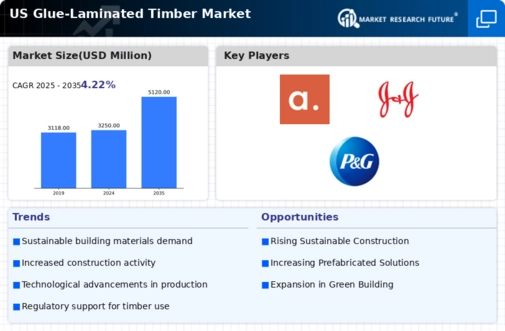Rising Demand for Sustainable Construction
The glue laminated-timber market is experiencing a notable increase in demand driven by the growing emphasis on sustainable construction practices. As environmental concerns gain traction, builders and architects are increasingly opting for eco-friendly materials. Glue laminated timber, known for its renewable nature and lower carbon footprint, aligns well with these sustainability goals. In the US, the construction sector is projected to grow at a CAGR of approximately 5% over the next few years, further boosting the demand for sustainable materials. This shift towards green building practices is likely to enhance the glue laminated-timber market, as it offers a viable alternative to traditional materials like steel and concrete, which have higher environmental impacts.
Technological Advancements in Manufacturing
Technological innovations in the manufacturing processes of glue laminated timber are significantly impacting the market. Enhanced production techniques, such as automated cutting and precision gluing, have improved the efficiency and quality of the final products. These advancements not only reduce waste but also lower production costs, making glue laminated timber more competitive against other building materials. The US market is witnessing a surge in the adoption of these technologies, with manufacturers investing in state-of-the-art equipment. This trend is expected to drive the glue laminated-timber market forward, as improved product quality and cost-effectiveness attract more builders and developers.
Increased Investment in Infrastructure Projects
the glue laminated-timber market will benefit from increased investment in infrastructure projects across the US. Government initiatives aimed at enhancing public infrastructure, such as bridges, schools, and recreational facilities, are likely to create substantial demand for durable and sustainable building materials. Glue laminated timber, with its strength and aesthetic appeal, is becoming a preferred choice for many of these projects. Recent reports indicate that infrastructure spending in the US is expected to reach $1 trillion by 2027, which could significantly bolster the glue laminated-timber market as more projects incorporate this versatile material.
Growing Popularity of Prefabricated Construction
the glue laminated-timber market is becoming popular due to the increasing trend of prefabricated construction. This method, which involves assembling building components off-site, offers numerous advantages, including reduced construction time and minimized waste. Glue laminated timber is particularly well-suited for prefabrication, as it can be manufactured to precise specifications and easily transported. The US construction industry is gradually shifting towards prefabricated solutions, with estimates suggesting that the market for prefabricated buildings could grow by over 10% annually. This trend is likely to enhance the glue laminated-timber market, as builders seek efficient and sustainable materials for their projects.
Enhanced Aesthetic Appeal in Architectural Design
The glue laminated-timber market is benefiting from the growing recognition of its aesthetic appeal in architectural design. Architects and designers are increasingly incorporating glue laminated timber into their projects due to its natural beauty and versatility. This material allows for creative and innovative designs, which can enhance the overall visual impact of structures. In the US, there is a rising trend towards using wood in modern architecture, with glue laminated timber being favored for its ability to create open spaces and unique structural forms. This shift in design preferences is likely to drive demand in the glue laminated-timber market, as more projects seek to combine functionality with aesthetic value.














Leave a Comment